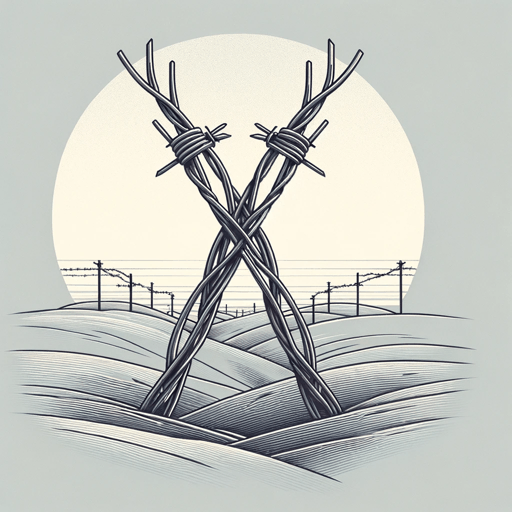53 pages • 1 hour read
John KeeganThe First World War
Nonfiction | Reference/Text Book | Adult | Published in 1999A modern alternative to SparkNotes and CliffsNotes, SuperSummary offers high-quality Study Guides with detailed chapter summaries and analysis of major themes, characters, and more.
Important Quotes
“A child’s show in the Polish dust, a scrap of rusting barbed wire, a residue of pulverized bone near the spot where the gas chambers worked, these are as much relics of the First as of the Second World War. They have their antecedents in the scraps of barbed wire that litter the fields where the trenches ran, filling the French air with the smell of rust on a damp morning, in the mildewed military leather a visitor finds under a hedgerow, in the verdigris brass of a badge or button, corroded clips of ammunition and pockmarked shards of shell.”
(Chapter 1, Page 4)
In addition to the horrors it produced on its own, the First World War gave rise to the Second in two critical ways. The first was the political, the wreckage of the old European system that left Germany defeated but its neighbors sufficiently weakened so that Germany could attempt to build a new hegemonic order a generation later. In carrying out that effort, the Nazi regime innovated a system of industrial-scale killing, which the First World War brought to Europe.
“Undirected fire is wasted effort, unless observers can correct its fall, order shifts of target, signal success, terminate failure, co-ordinate the action of infantry with its artillery support. The communication necessary to such co-ordination demands, if not instantaneity, then certainly the shortest possible interval between observation and response. Nothing in the elaborate equipment of the European armies of the early twentieth century provided such facility. Their means of communication were at worst word of mouth, at best telephone and telegraph. A telephone and telegraph depended upon preserving the integrity of fragile wires, liable to be broken as soon as action was joined, word of mouth offered the only standby in a failure of communication, consigning commanders to the delays and uncertainties of the earliest days of warfare.”
(Chapter 1, Page 22)
Here Keegan is discussing how the technology of the war had not yet been integrated into a system for delivering on its promised effectiveness. Massive firepower was useless without the knowledge and technical wherewithal to direct it where it needed to go. This observation also represents a microcosm of the war itself, where enormous effort was directed with little strategic effect because the warring powers lacked the actual capacity to make proper use of the destructive apparatus at their disposal.
“It is not surprising, therefore, to find buried in the text of the Great Memorandum its author’s admission that ‘we are too weak’ to bring the plan to a conclusion and, in a later amendment, ‘on such an extended line we shall need greater forces than we have so far estimated.’ He had run into a logical impasse. Railways would position the troops for his great wheel; the Belgian and French roads would allow them to reach the outskirts of Paris in the sixth week from mobilization day; but they would not arrive in the strength necessary to win a decisive battle unless they were accompanied by eight corps—200,000 men—for which there was no room.”
(Chapter 2, Page 36)
In the years leading up to the war, the capacity to mobilize millions of soldiers and deploy them over vast distances culminated in the belief that there would be a decisive engagement, awarding victory to whomever moved fastest. In the course of planning its own mobilization, the German General Staff realized that it was logistically impossible for them to deploy a sufficient number of forces at the point where they were most likely to confront the bulk of the French force.

